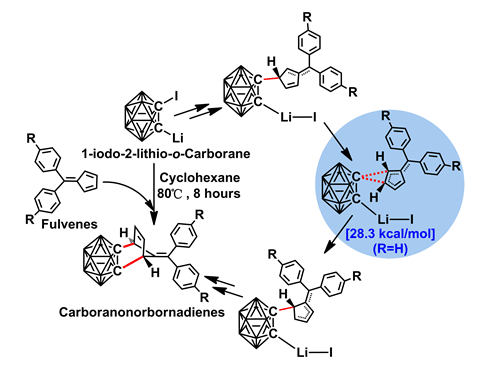| [1] Li, Y.; Li, W.; Zhang, J. Chem. Eur. J. 2017, 23, 467.
[2] Pellissier, H. Chem. Rev. 2016, 116, 14868.
[3] Wei, L.; Wang, C.-J. Chem. Commun. 2015, 51, 15374.
[4] Ai, W.; Liao, D.; Lei, X. Chin. J. Org. Chem. 2015, 35, 1615(in Chinese). (艾文英, 廖道红, 雷晓光, 有机化学, 2015, 35, 1615.)
[5] Liu, W.; Wu, Y.; Li, L.; Li, X. Chin. J. Org. Chem. 2016, 36, 1501(in Chinese). (刘文香, 吴宇强, 李灵芝, 李霞, 有机化学, 2016, 36, 1501.)
[6] Cao, M.-H.; Green, N. J.; Xu, S.-Z. Org. Biomol. Chem. 2017, 15, 3105.
[7] Xie, M.; Lin, L.; Feng, X. Chem. Rec. 2017, 17, 1.
[8] Fang, D.; Chen, Y. Acta Chim. Sinica 2014, 72, 253(in Chinese). (方德彩, 陈彦梅, 化学学报, 2014, 72, 253.)
[9] Ran, Y.; Tang, M.; Wang, Y.; Wang, Y.; Zhang, X.; Zhu, Y.; Wei, D.; Zhang, W. Tetrahedron 2016, 72, 5295.
[10] Musavi, S. M.; Amani, J.; Omidian, N. Tetrahedron 2014, 70, 708.
[11] Li, Y.; Fang, D.-C. Phys. Chem. Chem. Phys. 2014, 16, 15224.
[12] Tang, M.; Wu, Y.; Liu, Y.; Cai, M.; Xia, F.; Liu, S.; Hu, W. Acta Chim. Sinica 2016, 74, 54(in Chinese). (唐敏, 吴永, 刘源, 蔡茂强, 夏飞, 刘顺英, 胡文浩, 化学学报, 2016, 74, 54.)
[13] Yang, Y.-F.; Liang, Y.; Liu, F.; Houk, K. N. J. Am. Chem. Soc. 2016, 138, 1660.
[14] Duan, A.; Yu, P.; Liu, F.; Qiu, H.; Gu, F. L.; Doyle, M. P.; Houk, K. N. J. Am. Chem. Soc. 2017, 139, 2766.
[15] Yang, Y.; Liu, Q.; Zhang, L.; Yu, H.; Dang, Z. Organometallics 2017, 36, 687.
[16] Li, Y.; Du, S. RSC Adv. 2016, 6, 84177.
[17] Diamond, O. J.; Marder, T. B. Org. Chem. Front. 2017, 4, 891.
[18] Ess, D. H.; Jones, G. O.; Houk, K. N. Adv. Synth. Catal. 2006, 348, 2337.
[19] Yu, P.; Yang, Z.; Liang, Y.; Hong, X.; Li, Y.; Houk, K. N. J. Am. Chem. Soc. 2016, 138, 8247.
[20] Yu, P.; Li, W.; Houk, K. N. J. Org. Chem. 2017, 82, 6398.
[21] Pellissier, H. Adv. Synth. Catal. 2016, 358, 2194.
[22] Mojica, M.; Méndez, F.; Alonso, J. A. Molecules 2016, 21, 200.
[23] Oliveira, B. L.; Guo, Z.; Bernardes, G. J. L. Chem. Soc. Rev. 2017, 46, 4895.
[24] Fell, J. S.; Lopez, S. A.; Higginson, C. J.; Finn, M. G.; Houk, K. N. Org. Lett. 2017, 19, 4504.
[25] Liu, F.; Liang, Y.; Houk, K. N. J. Am. Chem. Soc. 2014, 136, 11483.
[26] Levandowski, B. J.; Zou, L.; Houk, K. N. J. Comput. Chem. 2016, 37, 117.
[27] Zhang, J.; Qiu, Z.; Xu, P.-F.; Xie, Z. ChemPlusChem 2014, 79, 1044.
[28] Tang, C.; Xie, Z. Angew. Chem., Int. Ed. 2015, 54, 7662.
[29]
(a) Lyu, H.; Quan, Y.; Xie, Z. Angew. Chem., Int. Ed. 2015, 54, 10623;
(b) Lyu, H.; Quan, Y.; Xie, Z. J. Am. Chem. Soc. 2016, 138, 12727.
[30] Lee, C.; Yang, W.; Parr, R. G. Phys. Rev. B 1988, 37, 785.
[31] Becke, A. D. J. Chem. Phys. 1993, 98, 5648.
[32] Frisch, M. J.; Trucks, G. W.; Schlegel, H. B.; Scuseria, G. E.; Robb, M. A.; Cheeseman, J. R.; Scalmani, G.; Barone, V.; Mennucci, B.; Petersson, G. A.; Nakatsuji, H.; Caricato, M.; Li, X.; Hratchian, H. P.; Izmaylov, A. F.; Bloino, J.; Zheng, G.; Sonnenberg, J. L.; Hada, M.; Ehara, M.; Toyota, K.; Fukuda, R.; Hasegawa, J.; Ishida, M.; Nakajima, T.; Honda, Y.; Kitao, O.; Nakai, H.; Vreven, T.; Montgomery, J. A., Jr.; Peralta, J. E.; Ogliaro, F.; Bearpark, M.; Heyd, J. J.; Brothers, E.; Kudin, K. N.; Staroverov, V. N.; Keith, T.; Kobayashi, R.; Normand, J.; Raghavachari, K.; Rendell, A.; Burant, J. C.; Iyengar, S. S.; Tomasi, J.; Cossi, M.; Rega, N.; Millam, J. M.; Klene, M.; Knox, J. E.; Cross, J. B.; Bakken, V.; Adamo, C.; Jaramillo, J.; Gomperts, R.; Stratmann, R. E.; Yazyev, O.; Austin, A. J.; Cammi, R.; Pomelli, C.; Ochterski, J. W.; Martin, R. L.; Morokuma, K.; Zakrzewski, V. G.; Voth, G. A.; Salvador, P.; Dannenberg, J. J.; Dapprich, S.; Daniels, A. D.; Farkas, O.; Foresman, J. B.; Ortiz, J. V.; Cioslowski, J.; Fox,D. J. Gaussian 09, Revision D.01, Gaussian, Inc., Wallingford, CT, 2013.
[33] Reed, A. E.; Curtiss, L. A.; Weinhold, F. Chem. Rev. 1988, 88, 899.
[34] Reed, A. E.; Weinstock, R. B.; Weinhold, F. J. Chem. Phys. 1985, 83, 735.
[35] Carpenter, J. E.; Weinhold, F. J. Mol. Struct. 1988, 169, 41.
[36] Zhao, D.; Zhang, J.; Xie, Z. Angew. Chem., Int. Ed. 2014, 53, 12902.
[37] Qiu, Z.; Xie, Z. Dalton Trans. 2014, 43, 4925.
[38] Wang, S. R.; Xie, Z. Organometallics 2012, 31, 4544.
[39] Qiu, Z.; Ren, S.; Xie, Z. Acc. Chem. Res. 2011, 44, 299.
[40] Dang, Y.; Qu, S.; Tao, Y.; Song, C.; Wang, Z. X. J. Org. Chem. 2014, 79, 9046.
[41] Dub, P. A.; Béthegnies, A.; Poli, R. Organometallics 2012, 31, 294.
[42] Godbout, N.; Salahub, D. R.; Andzelm, J.; Wimmer, E. Can. J. Chem. 1992, 70, 560.
[43] Sosa, C.; Andzelm, J.; Elkin, B. C.; Wimmer, E.; Dobbs, K. D.; Dixon, D. A. J. Phys. Chem. 1992, 96, 6630.
[44] Miertus, S.; Scrocco, E.; Tomasi, J. Chem. Phys. 1981, 55, 117.
[45] Tao, J.-Y.; Mu, W.-H.; Chass, G. A.; Tang, T.-H.; Fang, D.-C. Int. J. Quantum Chem. 2013, 113, 975.
[46] Fang, D.-C. THERMO, Beijing Normal University, Beijing, China.
[47] Gonzalez, C.; Schlegel, H. B. J. Chem. Phys. 1989, 90, 2154.
[48] Gonzalez, C.; Schlegel, H. B. J. Phys. Chem. 1990, 94, 5523.
[49] Fukui, K. Acc. Chem. Res. 1981, 14, 363.
[50] Grimme, S. J. Comput. Chem. 2006, 27, 1787.
[51] Grimme, S.; Antony, J.; Ehrlich, S.; Krieg, H. J. Chem. Phys. 2010, 132, 154104.
[52] Chai, J.-D.; Head-Gordon, M. Phys. Chem. Chem. Phys. 2008, 10, 6615.
[53] Zhao, Y.; Truhlar, D. G. J. Phys. Chem. 2006, 110, 5121.
[54] Mu, W. H.; Xia, S. Y.; Li, J. X.; Fang, D. C.; Wei, G.; Chass, G. A. J. Org. Chem. 2015, 80, 9108. |
